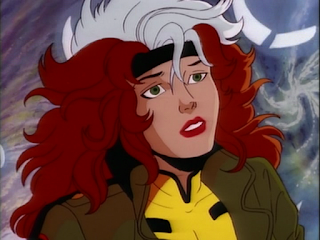Shell Game
Credits:
Louise Simonson (writer), Rob Liefeld and Co. (pencilers), Joe
Rubinstein and Co. (inkers), Brad Vancata (colors), Joe Rosen (letters)
Summary:
Storm, Rictor, Boom-Boom, Wolfsbane, and Warlock are teleported to
Genosha by Pipeline. Warlock is severely weakened by the transport and
near death. Cameron Hodge has the mutants placed in power-dampening
bodysuits and takes Warlock captive for experimentation. Warlock sneaks
away as Hodge argues with Dr. Moreau and frees his teammates. They’re
forced to leave him behind, but Wolfsbane soon returns to rescue
Warlock, who's taken captive once more. She witnesses Warlock turn into ashes as Hodge futilely tries
to steal his powers. Meanwhile, the remaining members of the X-Men and
New Mutants contact X-Factor.
Continuity Notes:
- This story is continued from the first chapter of “X-Tinction Agenda,” Uncanny X-Men #270.
- Storm at this point is an adolescent after being de-aged by Nanny.
- Rictor and Wolfsbane share their first kiss, paying off the romantic subplot that’s been building for a few issues.
Creative Differences:
The united X-Factor, X-Men, and New Mutants team gets a call from
Washington at the story’s end. An altered word balloon establishes that
the caller is Val Cooper, speaking on the President’s behalf, asking
them to travel to Washington.
Approved By The Comics Code Authority: Pipeline’s teleportation leaves the team naked, forcing the artists to cover them creatively for much of the issue.
“Huh?” Moment:
Wolfsbane suddenly disappears after Hodge invades the New Mutants’
cell and taunts them. (Her disappearance is even confirmed by
Boom-Boom’s dialogue.) Five pages later, Wolfsbane is back in their
cell, with no explanation.
Review:
Who doesn’t have nostalgic memories of “X-Tinction Agenda?” Just look
at those hand-lettered chapter numbers on the covers; they’re adorable.
Actually, even as a kid, my main interest in “X-Tinction Agenda”
resided in the Claremont/Lee Uncanny X-Men issues. I thought the art was too inconsistent in the X-Factor and New Mutants
chapters and simply lost interest in the story after a certain point.
Nine issues seemed excessively long for a crossover back in those days.
This
was one of the earliest Rob Liefeld comics I purchased as a kid, and
because I didn’t understand that this was a last-minute jam issue, I had
no idea what to make of his art. Some pages have an admirable amount
of polish, others just look like a muddy collection of shadows. You
never know when a character will look recognizably human, or devolve
into some kind of hunchbacked monster in-between panels (like Dr.
Moreau, for example.) The story isn’t served by the inconsistent art,
but Louise Simonson is able to extract some humanity out of the events.
Warlock’s sacrifice for the team, and their willingness to do the same
for him, is well played, and there’s certainly the sense that the stakes
have been appreciably raised in this adventure. Warlock’s actual death
scene isn’t nearly as emotional as his other scenes in the issue,
however, and it’s sad to see that this is an early case of an
established character being killed off in order to sell the significance
of a crossover.













